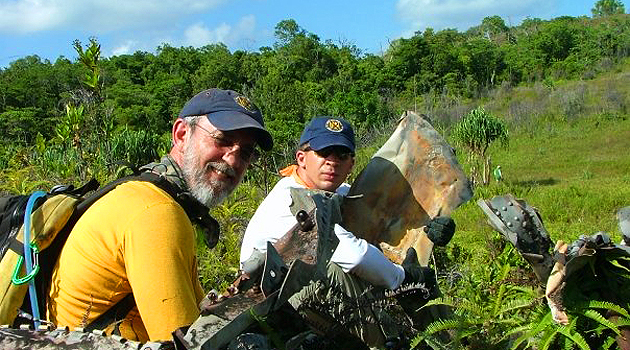A Search for Missing WWII Soldiers
SDSU Veterans Center intern Derek Abbey searches for the remains of missing soldiers in Palau.

Five hundred miles east of the Philippines in the untouched jungles of Palau, debris from a World War II aircraft may provide the missing link to the remains of more than 100 soldiers missing in action for six decades.
Derek Abbey, SDSU Veterans Center graduate student intern and U.S. Marine Corps major, hopes to find these clues during his third journey to Palau with the BentProp Project this March.
By helping recover the remains of missing in action (MIA) soldiers and prisoners of war (POWs), Abbey helps provide some resolution to family members who may still harbor doubts regarding their soldier’s fate.
“I take pride in honoring those who have served and who have made the ultimate sacrifice,” Abbey said. “It is my way to say thank you by answering the families’ questions about what happened to these soldiers.
“It’s surprising how large of a hole these questions have left in families, generations after the war."
Uncovering the past
The BentProp Project is a small volunteer group that takes monthlong missions to the islands of Palau in search of MIA soldiers and POWs from World War II. BentProp Project team members have backgrounds in scuba diving, WWII vintage aircraft and the history of American WWII involvement in the Pacific.
The mission of uncovering the past is not simple — project volunteers research year-round for information about crash sites. Many of the searches they conduct depend on information pieced together from government archives and records, World War II veterans’ accounts and help from local residents.
Although the undisturbed waters and jungles of Palau have preserved many of the artifacts of World War II aircraft crashes and land battles, the task of locating a specific crash site can be difficult.
“The things we find and the stories we hear seem to be connected to people and places all around the world,” said Abbey, a student at the University of San Diego. “Our people don’t believe in coincidence anymore.”
Last Flight Home
Abbey recently donated a copy of the documentary, Last Flight Home, to the SDSU Veterans Center. During the course of seven years, the documentary chronicles three BentProp Project searches in Palau and the families affected by them.
“Veterans often have an interest in the story,” Abbey said. “Especially because many of them have lost friends that they love and care for.”
The documentary covers a 2003 mission that led to the recovery of Arthur C. Miller, a crew member of an aircraft shot down in September 1944. After the war, Miller's remains were mistaken for those of a fellow crew member, Wesley Stuart.
However, Stuart’s mother never fully accepted the remains as her son's. After a 2005 site search failed to recover the remains of other crew members, Stuart’s sister had the remains DNA tested.
In 2009, DNA testing confirmed the remains as Miller's. In a full military funeral later that year, Miller’s remains were put to rest after 65 years.
Abbey attended Miller’s funeral service, among others where the BentProp Project played a role.
“At these services, there is the happiness that these long-lost servicemen have finally found their final resting place and the families can have an answer to the questions that went unanswered for so many years,” Abbey said.
“There is also a level of sadness for the loss of young life, having died for a cause that determined the path of our world history. These services have motivated me to continue the work of BentProp with the hopes of bringing more of these missing men home.”
Continuing the search
Abbey returns to Palau for his third quest with the BentProp Project this March.
To follow Abbey's mission online, visit www.bentprop.org.



